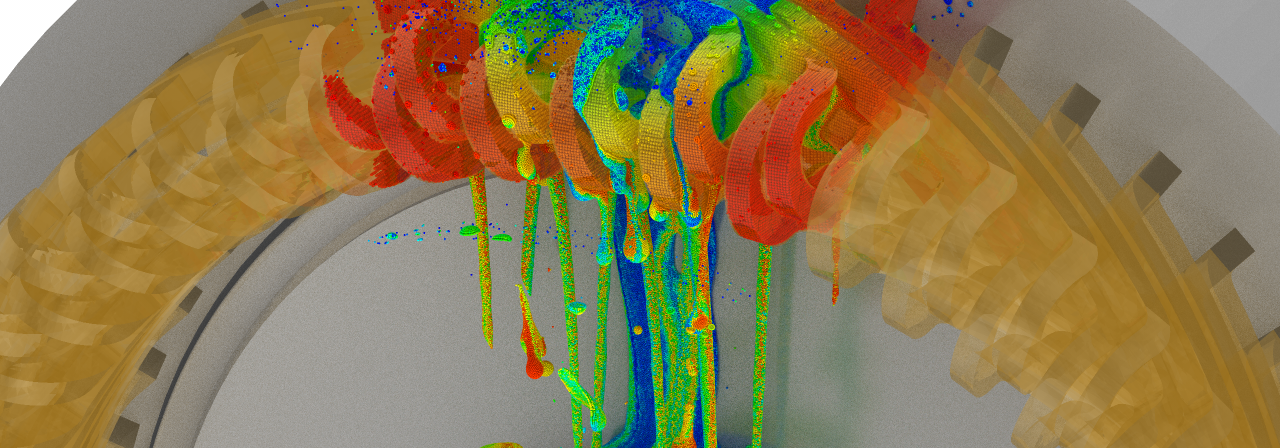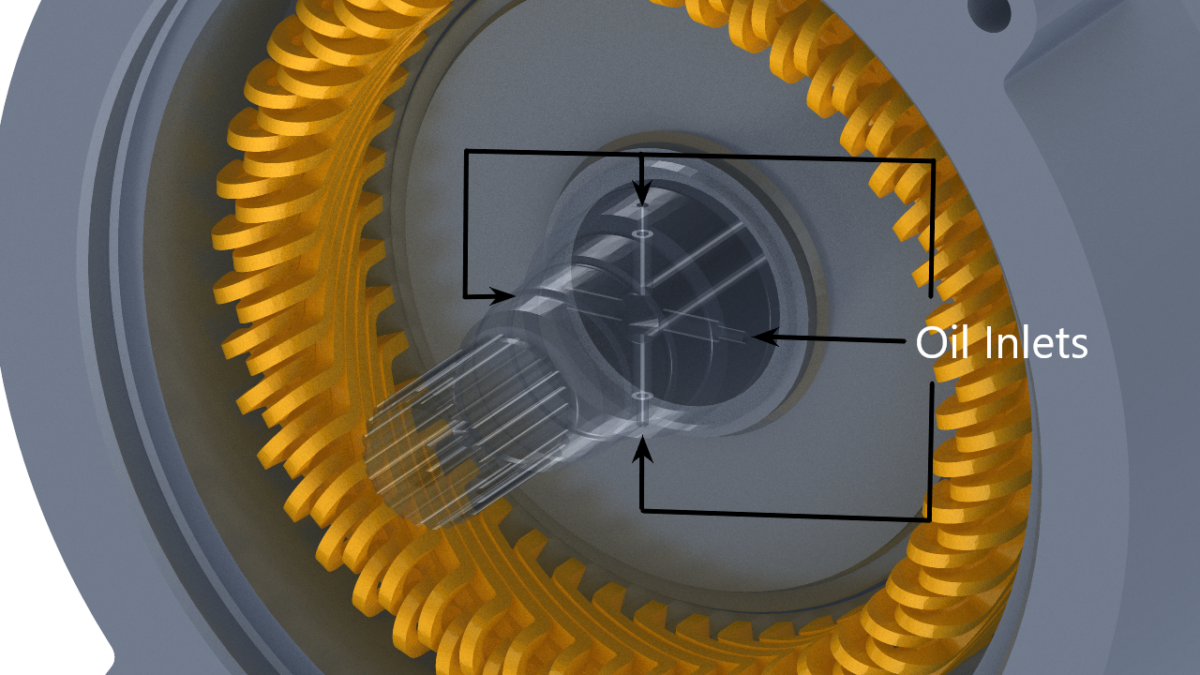

Running comprehensive simulations for e-motor cooling is complex and can be rather costly in terms of computational power.
In an e-motor, there are many moving as well as stationary components, and thereby, many surfaces for the cooling fluid to interact with. A particle-based simulation approach such as Smoothed Particle Hydrodynamics (SPH) used in PreonLab provides significant benefits in terms of flexibility and timesaving, since it is not necessary to mesh all these complex geometries before simulating the fluid flow and the resulting heat transfer. Another advantage is that SPH simulations do not require the presence of the air phase.
Furthermore, the Continuous Particle Size (CPS) feature of PreonLab allows a small particle size to be used in regions where there are small-scale geometries or a large amount of heat transfer, and efficiently increases the particle size of the fluid away from the regions of interest.
Apart from this, a volumetric heat source is necessary to best simulate the heat generated within the components of the e-motor. The user can model this phenomenon in PreonLab using the Heat Field feature. This heat source can be applied to the domain and controlled spatially via an embedded geometry or even a point cloud resource.
You can thus rapidly simulate several aspects of e-motor cooling to gain valuable insights to optimize your cooling strategy.
Simulations of the heat transfer for an impinging oil jet under different conditions were performed with PreonLab to validate the method against both experimental data and existing empirical models. A flat target as well as a textured surface replicating the surface of a copper end-winding inside an e-motor has been considered.

A cross-section of the result of the impinging jet on a flat surface.
Klos et al. [Klos2022] from Volkswagen have set themselves the goal of using numerical models for Conjugate Heat Transfer (CHT) simulation for future component analyses to reduce the effort of experimental investigations and save development costs and time. The greatest challenge is posed by the calculation of the oil free surface and the heat transfer between the components and the coolant. Therefore, a 3D simulation model of an oil spray cooling system was built to perform CHT simulations using PreonLab.
The results were assessed by comparing them with experimental measurements, and it was found that PreonLab was well-suited for performing CHT simulations of oil-cooled components.
Conclusions of the study:
[Klos2022]
F. Klos¹, S. Rothe¹, M. Hoffmann¹, O. Wünsch², S. Eulert¹, G.-F. Luehrs¹ 2022.
CHT-Simulationen von ölgekühlten Bauteilen.
AVL German Simulation Conference 2022, 28th September, Regensburg, Germany.
¹ Volkswagen AG, Group Components, Entwicklung E-Antriebe und Getriebe
² Universität Kassel, Institut für Mechanik, Fachgebiet Strömungsmechanik
Here are a few examples of different e-motor cooling simulations possible with PreonLab 5.2:
The image below shows the inlets, through which oil is emitted onto the hairpin stator (in yellow) from within the rotating shaft. The oil flows through the center of the shaft and is emitted outwards as the shaft rotates.

The cooling of the hairpins by the oil for this approach is shown in the following video.
The oil diffuses away from the shaft and spreads on the surface and inside the hairpins assembly where it absorbs heat from the hot surfaces. The color change corresponding to the temperature change of the oil can be observed quite well in the video above.
Similarly, the copper hairpins can also be cooled by oil which is emitted out of fixed injection points along the stator surface.
Conjugate heat transfer:
An important aspect of the cooling simulation is the analysis of the conjugate heat transfer between the oil and the hairpins. For this purpose, a solid solver is added to simulate the heat transfer within the stator. The resulting heat transfer can be observed in the following video:
In the video above, the particles are color-coded according to temperature. We can see that the copper hairpins have an initial temperature of 110°C. The temperature then rises within the solid solver because of the heat generated by the heat field (Joule loss).
The temperature reaches to around 116°C wherever the oil does not interact with the hairpins and red hotspots are created.
The hairpin temperature reduces at locations where the coolant is in contact as the oil gets hotter and absorbs heat. The oil in the video is color-coded with temperature as well.
Results within the stator:
Along with investigating the conjugate heat transfer between the oil and the hairpins at the surface, it can also be interesting to gain information about the heat distribution within the stator.
For this purpose, sensor planes can be used in combination with the solid solver to measure values at any location within solids – in this case, the hairpins.
It is thus possible to visualize hot spots within the solid, as it can be seen from the following video, and understand the effectiveness of the cooling method.
In addition to the two types of jet cooling, the e-motor could also be cooled by jacket cooling, where the coolant flows through channels without coming into direct contact with the internal components of the e-motor.
Details about this cooling can be found in the main article on e-motor cooling with PreonLab 5.2.

Image showing the temperature distribution within one section of the e-motor, which is being cooled by water flowing through the channels in the casing.
Apart from the effectiveness of cooling, information about the oil infiltration in the air gap between the rotating shaft and the stator can be vital for design engineers.
When it comes to optimizing the design of the e-motor, this oil infiltration needs to be minimized.
The air gap is considerably smaller than the other components of the e-motor and we need very fine particles at this location to resolve the flow properly during simulation.
Due to the large size ratio of the particles possible with the CPS feature, the infiltration of oil in the air gap can be analyzed as part of the same simulation along with the jet cooling simulation.
Without CPS, this would be rather difficult in terms of computational effort.

Oil infiltration in the air gap between the rotating shaft and the stator.